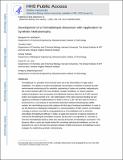| dc.contributor.author | Woolston, Benjamin M | |
| dc.contributor.author | Roth, Timothy | |
| dc.contributor.author | Kohale, Ishwar | |
| dc.contributor.author | Liu, David R | |
| dc.contributor.author | Stephanopoulos, Gregory | |
| dc.date.accessioned | 2021-10-27T20:09:25Z | |
| dc.date.available | 2021-10-27T20:09:25Z | |
| dc.date.issued | 2018 | |
| dc.identifier.uri | https://hdl.handle.net/1721.1/134839 | |
| dc.description.abstract | © 2017 Wiley Periodicals, Inc. Formaldehyde is a prevalent environmental toxin and a key intermediate in single carbon metabolism. The ability to monitor formaldehyde concentration is, therefore, of interest for both environmental monitoring and for metabolic engineering of native and synthetic methylotrophs, but current methods suffer from low sensitivity, complex workflows, or require expensive analytical equipment. Here we develop a formaldehyde biosensor based on the FrmR repressor protein and cognate promoter of Escherichia coli. Optimization of the native repressor binding site and regulatory architecture enabled detection at levels as low as 1 µM. We then used the sensor to benchmark the in vivo activity of several NAD-dependent methanol dehydrogenase (Mdh) variants, the rate-limiting enzyme that catalyzes the first step of methanol assimilation. In order to use this biosensor to distinguish individuals in a mixed population of Mdh variants, we developed a strategy to prevent cross-talk by using glutathione as a formaldehyde sink to minimize intercellular formaldehyde diffusion. Finally, we applied this biosensor to balance expression of mdh and the formaldehyde assimilation enzymes hps and phi in an engineered E. coli strain to minimize formaldehyde build-up while also reducing the burden of heterologous expression. This biosensor offers a quick and simple method for sensitively detecting formaldehyde, and has the potential to be used as the basis for directed evolution of Mdh and dynamic formaldehyde control strategies for establishing synthetic methylotrophy. | |
| dc.language.iso | en | |
| dc.publisher | Wiley | |
| dc.relation.isversionof | 10.1002/BIT.26455 | |
| dc.rights | Creative Commons Attribution-Noncommercial-Share Alike | |
| dc.rights.uri | http://creativecommons.org/licenses/by-nc-sa/4.0/ | |
| dc.source | PMC | |
| dc.title | Development of a formaldehyde biosensor with application to synthetic methylotrophy | |
| dc.type | Article | |
| dc.contributor.department | Massachusetts Institute of Technology. Department of Chemical Engineering | |
| dc.contributor.department | Massachusetts Institute of Technology. Department of Biological Engineering | |
| dc.relation.journal | Biotechnology and Bioengineering | |
| dc.eprint.version | Author's final manuscript | |
| dc.type.uri | http://purl.org/eprint/type/JournalArticle | |
| eprint.status | http://purl.org/eprint/status/PeerReviewed | |
| dc.date.updated | 2019-09-11T18:09:32Z | |
| dspace.orderedauthors | Woolston, BM; Roth, T; Kohale, I; Liu, DR; Stephanopoulos, G | |
| dspace.date.submission | 2019-09-11T18:09:34Z | |
| mit.journal.volume | 115 | |
| mit.journal.issue | 1 | |
| mit.metadata.status | Authority Work and Publication Information Needed | |
